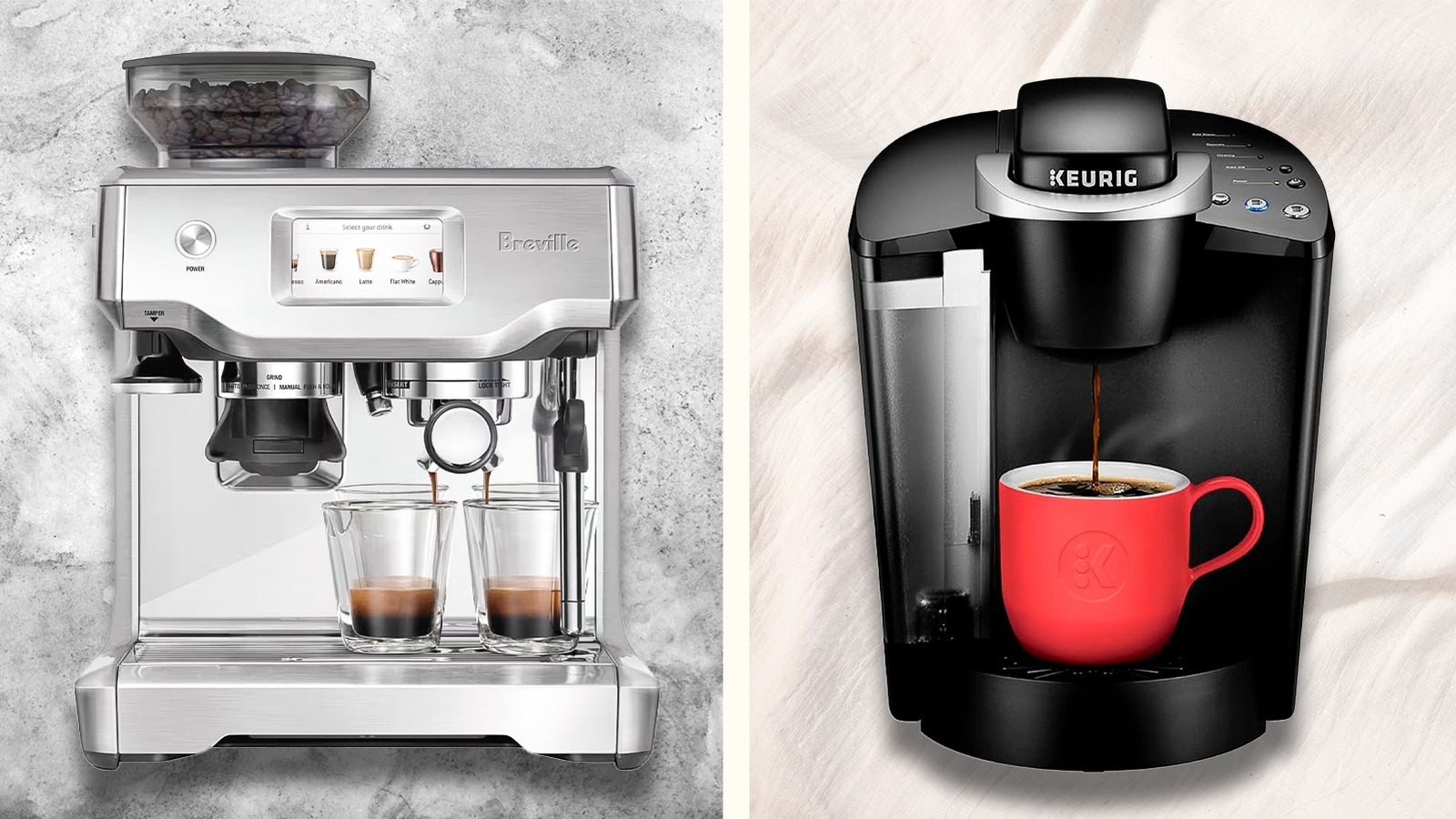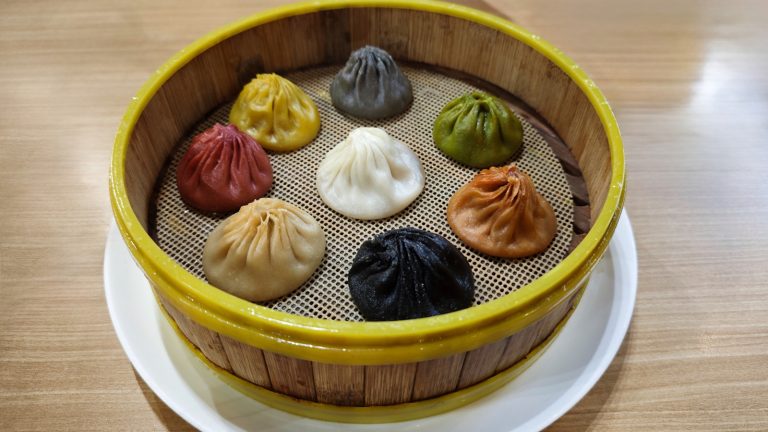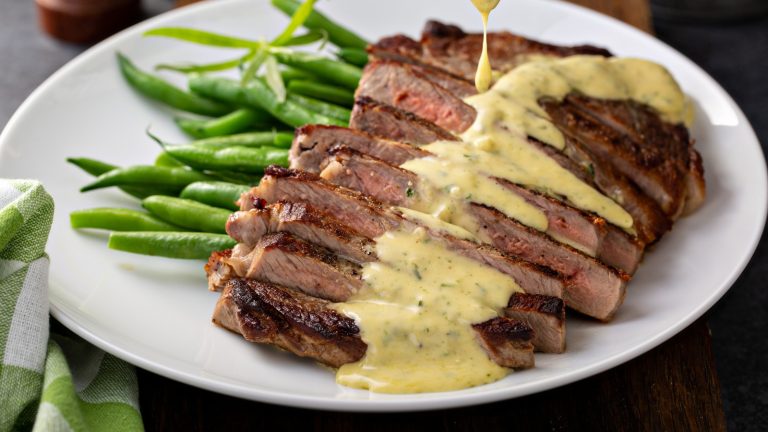The first step to making coffee drinks at home is investing in a machine to make them with. For that, you’ll come across an almost overwhelming array of options — from different brands making similar machines, such as Nespresso and Keurig, to different machines made by different brand names, like the coffee makers from Mr. Coffee and the espresso machines from La Marzocco. But if you’re going to start anywhere, you need to start by knowing what type of coffee maker you’re looking for in the first place.
The type of machine you need depends on the type of coffee you drink and, in turn, the type of coffee said machine can actually prepare. It’s that line of thinking that will have brought you here, trying to decipher exactly what the difference is between an espresso machine and a coffee maker. While the terms may be used interchangeably (and often incorrectly), the major difference between an espresso machine and a coffee maker is the type and variety of coffee drinks that the appliances are designed to prepare. Let’s dive into what those drinks are and which choice might be best for you and your path to becoming an at-home barista.
What is an espresso machine?
First things first, what is an espresso machine? Rather unsurprisingly, it’s exactly what it sounds like: a machine that makes espresso and espresso only. But while that might sound very limiting, it’s actually not. In fact, most of the drinks you find on the Starbucks menu — or any other coffee menu, for that matter — start with espresso. Be it an iced or hot latte, a cappuccino, an Americano, or a dirty chai, having an espresso machine is your first step toward making all kinds of craft coffee drinks at home.
At the same time, there are different types of espresso machines that you can buy. Semi-automatic espresso machines, for instance, are some of the most widely used, while super automatic espresso machines (which require no hands on work whatsoever) are the second most popular. From there, you have options like the automatic and manual machines you see much more often in coffee shops than inside of anyone’s home. Each of these options are espresso machines and, at the end of the day, they each make you the same thing: espresso and espresso-based drinks.
What is a coffee maker?
While a coffee maker can be used to generally describe any appliance that produces coffee — including an espresso machine, however technically incorrect — it is more accurately used to distinguish appliances like drip coffee machines, French presses, or pour-over coffee makers from espresso machines. Again, when comparing coffee makers to espresso machines, the main difference is the type of coffee that the coffee maker actually creates. In this case, that’d be coffee in its most basic form.
Although espresso machines make what many might consider to be the more trendy form of coffee drinks — those mixed with espresso and milk along with any sort of coffee syrup flavors and toppings — coffee makers tend to be the most common type of coffee machines found in people’s homes. Part of the reason why is because of how simple they are to use, as well as the simplicity of the coffee itself. That all comes down to its mechanics and maintenance.
Espresso machines make espresso, and coffee makers make coffee
To put it simply: Espresso machines make espresso, while coffee makers make coffee. But why is that? It all comes down to how the machines are designed. For instance, espresso machines are made to take a small amount of ground espresso beans and concentrate them in water for a short period of time. You can get super technical with this, too, weighing and measuring the beans, using an espresso tamper, and timing the pull of your espresso shots. Coffee makers, on the other hand, operate a lot differently.
Coffee makers take ground coffee beans held in a filter and force hot water through them — although they do it much more slowly and in a much less concentrated form than an espresso machine would. The result is a full cup or carafe filled with what most would describe to be the most basic form of coffee. Other coffee machines, like French presses and pour overs, operate in the same way. However, you could consider these machines the equivalent of a manual coffee machine in that they offer a much more hands on and customizable process.
Knowing what your machine is designed to make and what it’s not, you can get an idea of that actual variety of drinks that each will provide. But while coffee makers might be more limited in that they can really only make basic coffee, they do have some pros when it pertains to maintenance.
Coffee makers require much less upkeep than espresso machines
On the one hand, some might consider the coffee machine’s simplicity a drawback, but it does come with the advantage of easier maintenance compared to an espresso machine. The latter need to have their various parts regularly cleaned, including the portafilter, the group head, and the steam wand (if it has one). It also requires regular descales in order to maintain its internal parts — a rule which applies to semi-automatic and super-automatic espresso machines like your Nespresso machine too.
When you have a coffee maker, all you really have to worry about cleaning regularly is the actual filter itself and the carafe that it pours your coffee into. About once a month, you’ll also want to run some water and vinegar through the system. This makes it a much less hassle free machine. Depending on your machine, you may even be able to throw the parts in the dishwasher to make your job even easier. This same thing goes if you’re using a French press or pour over to make your coffee, as well, with the exception of the French press technique for an easier clean up. But apart from the difference in cleaning and maintaining these machines, you’ll also need to take note of the type of coffee beans you buy and use with them.
Espresso beans are for espresso machines, and coffee beans are for coffee machines
Going along with the different types of coffee drinks that espresso machines and coffee machines can prepare is the difference in the actual coffee beans they take. Fortunately, it’s equally as simple to differentiate — stick with espresso beans for your espresso machine, and coffee beans for your coffee machine. While they are, essentially, both beans from the same plant, the difference between coffee beans and espresso beans lies in the way that they are roasted, which impacts the flavor and quality of the coffee drinks you prepare.
Espresso beans are usually roasted much longer and darker than coffee beans are. Regular coffee beans, on the other hand, come in a variety of roasts, including light, medium, and dark, but they’re generally roasted for a much shorter time than espresso beans are. Roasted this way, espresso beans come with a natural, oily sheen that is responsible for the coffee drink’s signature layer of crema, along with its rich and creamy concentrated flavor.
While you could use dark roast coffee beans to make espresso in your machine, they will not produce the same consistency or flavor intensity. Similarly, while it is possible to use espresso beans in your coffee maker, you might find the taste much too bitter and strong. Also, depending on how finely ground it is and the type of coffee maker you use, it could end up causing you some other issues.
The way you grind your beans matters whether you use a coffee maker or an espresso machine
Grind size is important, no matter if you’re using an espresso machine or a coffee maker. The point is that they’re different — and it all comes down to the mechanics. Not only are espresso beans roasted longer and darker, but they need to be ground much more finely than coffee beans. This is because of the high pressure nature in which the machines work, allowing the most extraction possible in a short period of time. Knowing that, you’ll have to pay attention to how uniformly and finely you grind them without grinding them too much.
Coffee beans, on the other hand, are intended to be ground much more coarsely. This also has to do with the way in which it’s brewed. Coffee beans are meant to be brewed much more slowly and under much less pressure than espresso beans, and the coarseness of the beans actually works to aid in that by further slowing the brewing process. This allows the flavor of the beans to be fully extracted and provides you with a nice and full coffee flavor. If you were to use finely ground espresso in your coffee maker, the beans would be extracted much too quickly and come out over-extracted. But the same rule would also apply if you were to use coarsely ground coffee in your espresso machine, too, leading to under-extraction.





